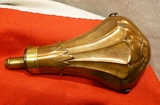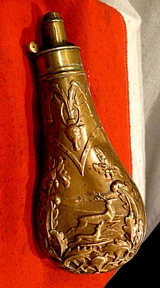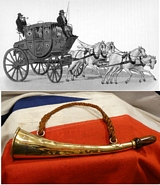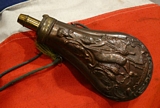Antique Arms & Militaria
A Good 19th Century Powder Flask
Fluted copper body and brass adjustable spout. read more
175.00 GBP
A Good 19th Century Sykes Pistol Powder Flask
Absolutely ideal for pistol casing. A nice example with a few small dents. Small pistol flasks are certainly the most desireable type as they can beautifully set off a cased pistol set [and thus increase it's value dramatically], for either a flintlock or percussion gun, that is lacking it's original flask. 4.5 inches long read more
295.00 GBP
A Very Nice 19th Century Dixon & Son Pistol Powder Flask
In nice order with working spring spout with three adjustable gram measures. 4.75 inches long overall. A delightful piece with pressed shell pattern in copper with gilt spout. Super patina. read more
340.00 GBP
A Very Fine. 19th Century Shaped Copper Powder Flask
With good adjustable spout measure and tight spring. read more
195.00 GBP
A Good French Boche Powder Flask, 19th Century, Shell Pattern
By Boche of Paris, a fine quality flask with good working spring action. Boche apparently signed only his best examples and flasks by Boche belong to the highest in society. read more
195.00 GBP
A Fine Victorian G & J W Hawksley Powder Flask
A very good copper and brass powder flask for a gun with the oak leaf design incorporating a fox and stag head, the nozzle stamped Drams and graduation values of 2?, 2?, 2? , the nozzle signed G & J. W. Hawksley, slight dent one side at the top of the body, and in working order. Overall 8 by 3? inches.
See THE POWDER FLASK BOOK, Ray Riling page 315 fig 580.
Riling says in the book that the flask illustrated as fig 580 was made by Hawksley for Barton of New York and implies that this was an exclusive design to them and does not mention having seen one marked Hawksley which might suggest that this is rare. read more
225.00 GBP
A Most Interesting French Post Chaise Horn. Brass Trumpet, Horn Mouthpiece.
19th century. In France and Switzerland in the Alp regions, as the post chaise drives around the numerous deadly bends, on the mountain passes, in the fog, the post chaise horn is blown to warn on-coming vehicles. Of course the British poste chaise used them as well but this one is French made. A post chaise, is a four-wheeled, closed carriage, containing one seat for two or three passengers, that was popular in 18th-century England and France. The body was of the coup? type, appearing as if the front had been cut away. Because the driver rode one of the horses, it was possible to have windows in front as well as at the sides. At the post chaise?s front end, in place of the coach box, was a luggage platform. The carriage was built for long-distance travel, and so horses were changed at intervals at posts (stations).In England, public post chaises were painted yellow and could be hired, along with the driver and two horses, for about a shilling a mile. The post chaise is descended from the 17th-century two-wheeled French chaise. read more
125.00 GBP
A Most Attractive 19th Century Powder Flask Decorated With Game
Embossed on both sides with roccoco moulding and panels of hanging game including, stags and large game birds. Brass spout with god spring action. All original lacquer present. read more
185.00 GBP
A Nice 19th Century Patent Powder Flask
A jolly attractive flask in nice operating order with original lacquer finish. Decorated with stags and hounds on both sides. read more
195.00 GBP
A Good Plain Sykes Patent Copper Powder Flask. Early 19th Century.
Good working spring action and measure. read more
155.00 GBP











